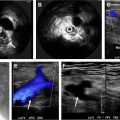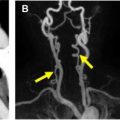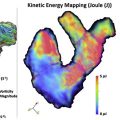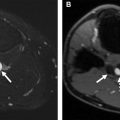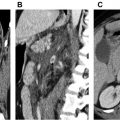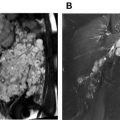Blood flow through the heart and great vessels is sensitive to time and multiple velocity directions. The assessment of its three-dimensional nature has been limited. Recent advances in magnetic resonance imaging (MRI) allow the comprehensive visualization and quantification of in vivo flow dynamics using four-dimensional (4D)-flow MRI. In addition, the technique provides the opportunity to obtain advanced hemodynamic measures. This article introduces 4D-flow MRI as it is currently used for blood flow visualization and quantification of cardiac hemodynamic parameters. It discusses its advantages relative to other flow MRI techniques and describes its potential clinical applications.
Key points
- •
Four-dimensional (4D)-flow magnetic resonance imaging (MRI) provides a comprehensive analysis of complex blood flow in the aortic valve and thoracic aorta..
- •
Recent advances in 4D flow MRI have shortened scanning time, improved pre-processing analysis, and visualization tools, thereby facilitating its clinical feasibility.
- •
4D flow MRI facilitates the assessment of aortic and valve diseases using multiplanar visualization, flexible retrospective flow quantification (forward flow, reverse flow, regurgitant fraction, and peak velocity), 3D blood flow velocity visualization and advanced research metrics (flow displacement, wall shear stress, and turbulent kinetic energy).
Introduction
Knowledge of cardiovascular anatomy and hemodynamic function is vital for detecting, diagnosing, and managing cardiovascular diseases. A comprehensive understanding of these factors is essential for delivery of optimal clinical care. Cardiac magnetic resonance imaging (MRI) is a valuable clinical tool because of its wide field of view, unlimited scanning planes, and excellent tissue contrast. Therefore, it is ideal for the assessment of cardiovascular anatomy and function. , The growing number of patients with cardiovascular diseases requires a detailed analysis of complex blood flow patterns in the whole heart and great vessels, thus allowing a better understanding of the underlying pathologic mechanisms.
Flow Imaging with Magnetic Resonance Imaging: From Two-dimensional to Four-dimensional
Phase-contrast (PC) MRI can be clinically used to quantify and visualize blood flow. This technique provides an opportunity for calculating a range of unique hemodynamic parameters that help clinicians and researchers improve lesion analysis and diagnosis. Conventional two-dimensional (2D) PC-MRI encodes only the time-resolved component of blood velocity that is perpendicular to or within the imaging plane and is a well-established technique to quantify blood flow. , However, peak blood flow velocity can be underestimated if the acquisition plane is not orthogonal to the vessel of interest or misplaced. , Therefore, minimizing these deleterious effects should improve any underestimation and subsequent interpretation based thereon. One strategy for reducing extrapolation operator inaccuracy is to consider all 3 principal velocity directions <SPAN role=presentation tabIndex=0 id=MathJax-Element-1-Frame class=MathJax style="POSITION: relative" data-mathml='(Vx,Vy,Vz)’>(??,??,??)(Vx,Vy,Vz)
( V x , V y , V z )
inside the vessel of interest (2D PC-MRI and 3 directions of encoding) and then the magnitude of the total velocity can be calculated by <SPAN role=presentation tabIndex=0 id=MathJax-Element-2-Frame class=MathJax style="POSITION: relative" data-mathml='V=(Vx2+Vy2+Vz2)’>?=(?2?+?2?+?2?)‾‾‾‾‾‾‾‾‾‾‾‾‾‾‾‾√V=(Vx2+Vy2+Vz2)
V = ( V x 2 + V y 2 + V z 2 )
. , , Alternatively, three-dimensional (3D) spatial encoding allows the acquisition of isotropic high spatial resolution and thus raises the possibility of measuring and visualizing blood flow at any location of 3D volume without restrictions to predefined imaging planes. , , , As such, the number of potential applications of four-dimensional (4D)-flow MRI has increased in recent years. , , In the past, the acquisition time of 4D-flow MRI was long, which made it challenging for use in routine clinical settings. However, recent developments in sparse sampling techniques have significantly shortened overall acquisition time to the clinically acceptable scan times (<10 minutes). , , The ability to provide comprehensive information on complex blood flow changes in cardiovascular disease and thus to derive advanced hemodynamic parameters has allowed 4D-flow MRI to be a useful tool in routine clinical practice. A summary of these properties is provided in Table 1 .
| Parameter | 4D-Flow MRI |
|---|---|
| Velocity encoding | Three-directional, full 3D velocity vector field |
| Respiration control | Navigator gating, bellows, self-gating techniques |
| Total scan time | 5–8 min (dependent on heart rate, efficiency of respiration control, type of acceleration imaging) |
| Anatomic coverage | 3D + time, modify for thoracic aorta and left ventricular outflow tract coverage, whole-heart coverage for congenital disease |
| Data analysis | Dedicated software packages for 3D flow visualization and quantification of standard MRI flow parameters |
| Flow visualization | 3D (pathlines, streamlines), complex flow 3D patterns viewed dynamically |
| Basic flow quantification | Retrospective analysis at any location within the acquired volume (peak velocity, net flow, regurgitant fraction) |
| Advanced hemodynamic quantification | Wall shear stress, flow displacement, 3D pressure difference maps, turbulent kinetic energy, viscous energy loss, vortex/helix flow |
Aortic Four-dimensional Flow
Time-resolved 3-directional 3D velocity (4D-flow) data, acquired using the cardiovascular MRI (CMR) parameters detailed in Table 2 , provide important information regarding intra-aortic blood flow and aortic valve function. Four-dimensional-flow MRI can be performed using axial, sagittal, or coronal oblique 3D volume. However, for assessment of aortic blood flow, 4D-flow MRI is usually obtained by using respiratory motion compensation and electrocardiogram (ECG) gating with full volumetric coverage of the thoracic aorta (including left ventricular outflow tract, ascending aorta, arch, and descending aorta) in an oblique-sagittal orientation. The generated 4 time-resolved (cine) 3D datasets are composed of magnitude data depicting anatomic structures and 3 time series velocity datasets representing the 3D blood flow velocities <SPAN role=presentation tabIndex=0 id=MathJax-Element-3-Frame class=MathJax style="POSITION: relative" data-mathml='(Vx,Vy,Vz)’>(??,??,??)(Vx,Vy,Vz)
( V x , V y , V z )
. A schematic showing the setup and acquisition of 4D-flow MRI of the aorta is shown in Fig. 1 .

